Too niche for Euro 7 adjustments
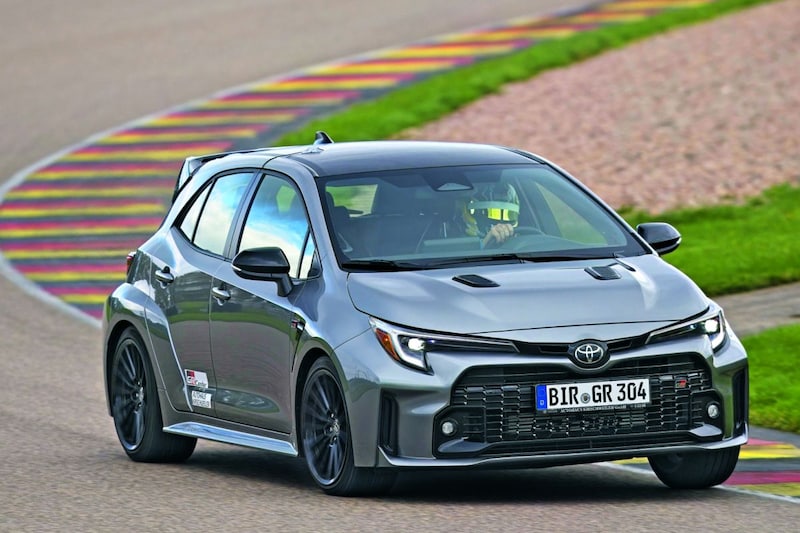

Officially it is not available in Europe, but we are very curious whether the Toyota GR Corolla would be a serious competitor to models such as the Volkswagen Golf R. So it is high time for a test.
Why didn’t the GR Corolla come to Europe?
It could have been so nice if Toyota had brought this GR Corolla to Europe. Then fans of the GR Yaris would be happy, have a suitable second car for the family and can look straight into the eyes of owners of a Golf R or Honda Civic Type R. Unfortunately, Europeans miss the net when they see such a fast Corolla. It is like the Hyundai Avante N that recently starred on this site. The Koreans and Japanese opt for a similar strategy: in the case of these types of niche models, they prefer not to invest money in adjustments to meet the Euro 7 emissions standard, such as the installation of a petrol particulate filter.
But the GR Yaris is doing quite well here, isn’t it?
Toyota has long since proven what it is capable of with the GR Yaris. That performance sold out in no time. Toyota has sent too few copies to our continent; some enthusiasts are still waiting for their car. The Supra and GR86 are nice, but not suitable options if you also want to take a family with you. And while there is indeed a Golf R competitor: the GR Corolla, only available on the other side of the Atlantic Ocean. How is it possible that you see such a Gazoo creation with a German license plate on these pages? Very simple, because there are companies that serve petrolheads with special tastes. Such as Toyota dealer Kirschweiler in Idar-Oberstein, Germany, who has no fewer than three copies of the Corolla GR. A perfect opportunity to put this creation through its paces.
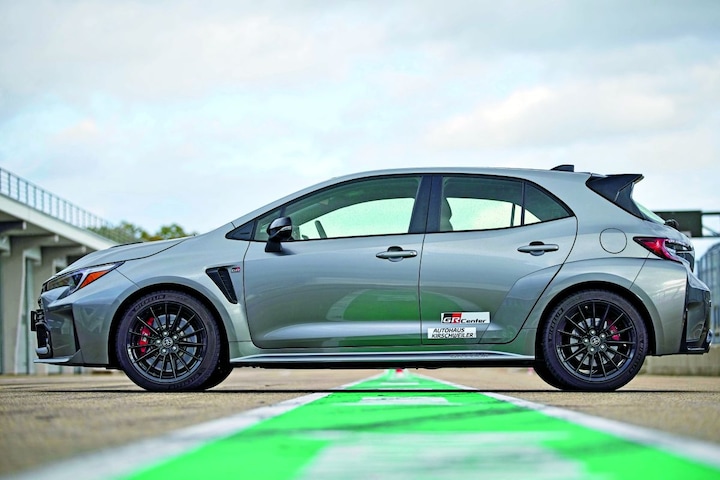
This Toyota GR Corolla belongs to the German GR Center Autohaus Kirschweiler.
The GR Yaris is already so expensive, what would GR Corolla cost?
Just sit back and relax: €86,480, without Dutch taxes that is. For comparison: in the US the dealer charges $35,900 for the basic Core version and $42,900 for the Circuit Edition that we drove. For anyone who now googles and types in ‘dollar converter’: this GR Corolla would have cost the equivalent of 32,700 and 39,180 euros respectively at the time of writing. More than 80,000 euros is a lot of money, but the amount obviously did not come out of the blue. At the relevant Toyota dealer they charge for: VAT, import duties, freight costs, carrying out modifications including lighting system and exhaust systems and carrying out WLTP tests, the installation of a red fog lamp plus the American dealer surcharge of approximately $15,000.
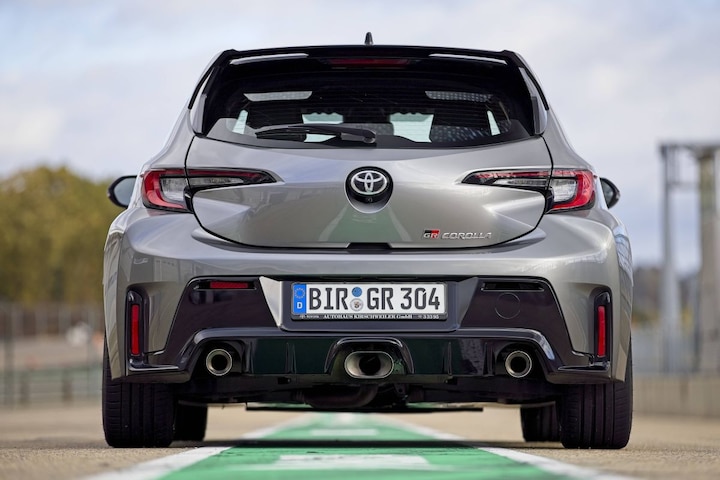
Is the GR Corolla worth that much?
Without having driven a meter we can give the answer: no, it is too expensive. Still, we want to know what we might be missing about it. How would it compare to the competition and its little brother, the Yaris? With its 305 hp, it indirectly competes against the Mercedes-AMG A 35, Audi S3, BMW M135i and Volkswagen Golf R. They also cost €70,000 and more, but then the Dutch bpm is already included.
But very special, right, such a GR Corolla?
First, a few facts about the technology. In principle we could suffice here with the comment ‘eight centimeters’. Excuse me? Yes, the only major difference between the GR Yaris and the ditto Corolla is the longer wheelbase of the four-door model. The rest is copied almost one-on-one from the little fun machine. Under the hood, the Corolla also has the most powerful series-produced three-cylinder engine in the world. However, in this case the 1.6 produces no less than 305 hp thanks to adjustments to the exhaust system and electronics, instead of 261 hp and 370 Nm. The oversized turbo is mounted on ball bearings. The motor itself is hydraulically mounted on one side to minimize vibration and unwanted movement. The only transmission option is a six-speed manual. The all-wheel drive is also taken from the Yaris and is said to be the lightest system on the market.
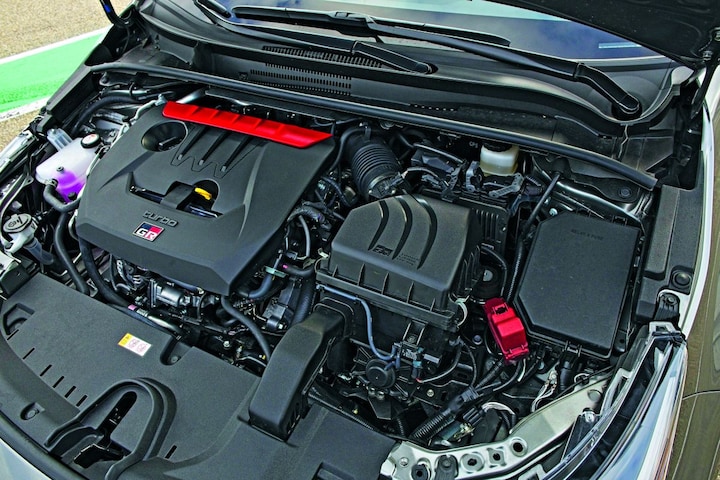
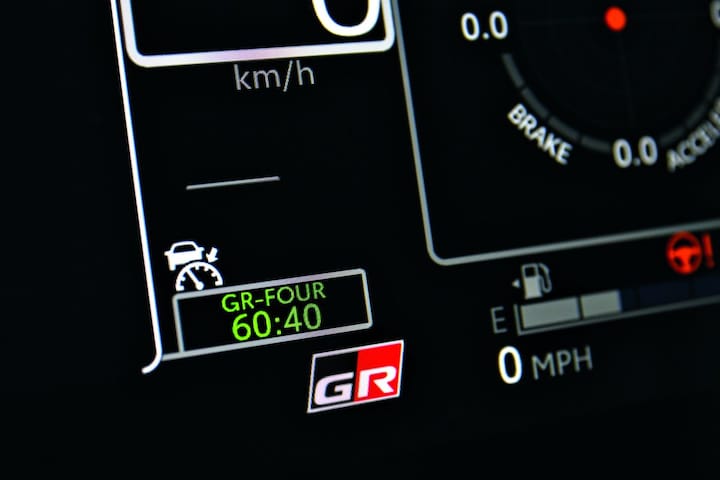
Does the four-wheel drive work the same as that of the little drift monster?
Yes, it is light but certainly not easy. The system features an aluminum central transfer case, which sends 60 percent of the power to the front wheels in normal mode. Then there’s the drift-oriented power split of 30:70, and in Track mode the split is 50:50. The Circuit Edition that we tested is also equipped with the Torsen limited slip differentials that we know from the GR Yaris, on both the front and rear axles.
And what about the brakes, wheels and suspension?
These are all taken one-on-one from the Yaris; the damper setting has been adapted to the higher weight and the longer wheelbase. The multi-spoke Enkei rims are half an inch wider. The Corolla is equipped with Michelin Pilot Sport 4 tires in size 235, against the GR Yaris tires in size 225/40 R18.
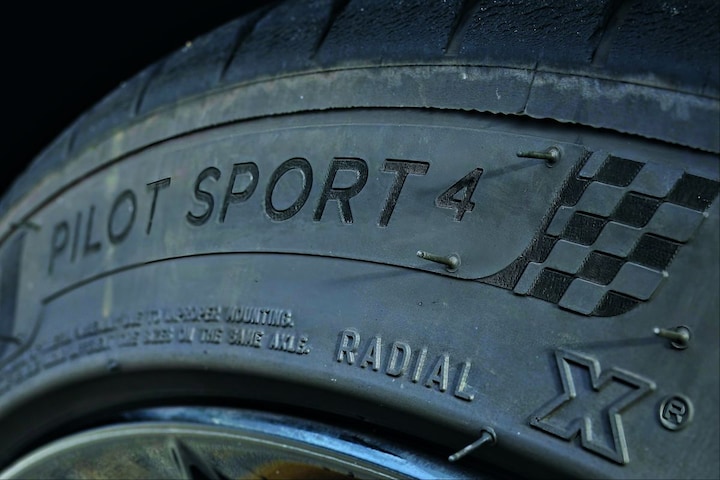
What has been modified compared to a regular Corolla?
The additional struts at the rear are aimed at optimizing torsional stiffness. And the bodywork? The front bumper is aggressively styled with a honeycomb grille and an air intake with grille in front, while the air outlets in the hood are reserved for the Circuit Edition. The wide wheel arches have multiple slots at the front and are placed on the body at the rear. Compared to the base model, they make the GR Corolla 20 millimeters wider at the front axle and 30 millimeters at the rear. The rear diffuser houses what is probably the most striking design detail of the Toyota GR Corolla: the three tailpipes of the exhaust system, the outer ones of which are classically round in shape, while the central element is oval.
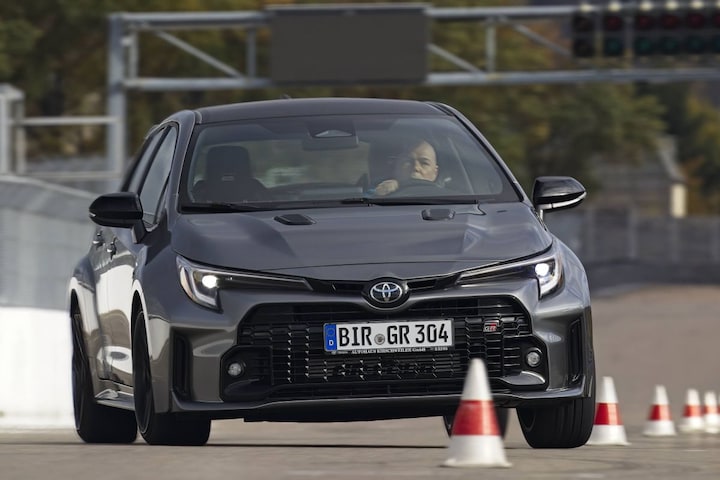
And what about the weight?
The roof is made of so-called forged carbon – say, forged carbon fiber – while the doors, hood and tailgate are made of aluminum, just like on the Yaris. All in all, the upper Corolla weighs 1,483 kilos, 200 more than the GR Yaris. The competition: a Mercedes-AMG A 35 weighs 1,567 kg, an Audi S3 1,533 kg, a BMW M135i 1,521 kg and a Golf R 1,504 kg. So we are not comparing apples and oranges.
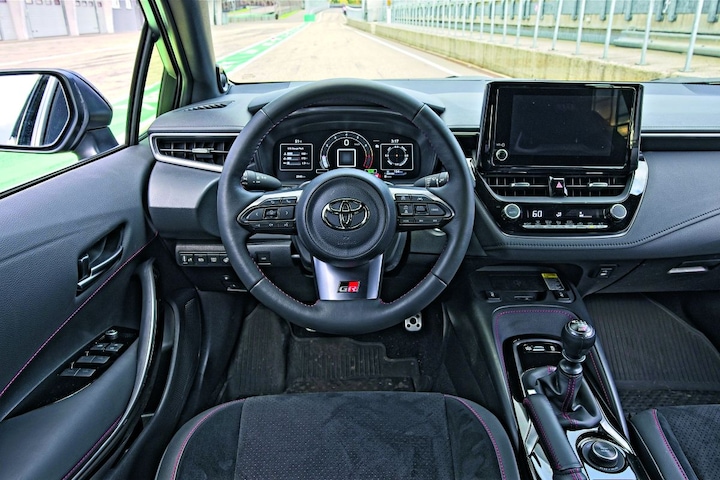
Also different from the normal inside?
It is not the first time that we have taken a seat in a Corolla, but it has been a long time since we got into one with a good dose of sportiness. In any case, the dashboard is successful, not too modern and too digital as with some brands, the seating position is a bit too high, the lateral support of the seats is good, the gear lever is within easy reach, the central screen in the middle is clear. classified. Behind the steering wheel is a digital display that you can configure to show a central round tachometer and a rev bar. The controls for the iMT intermediate throttle and the ESP setting are located to the left of the steering wheel, behind the gear lever is the switch for setting the four-wheel drive and above it the toggle switch with which you select the driving programs Eco, Normal, Sport and Custom. The steering ratio and accelerator pedal adjustment can be adjusted separately.
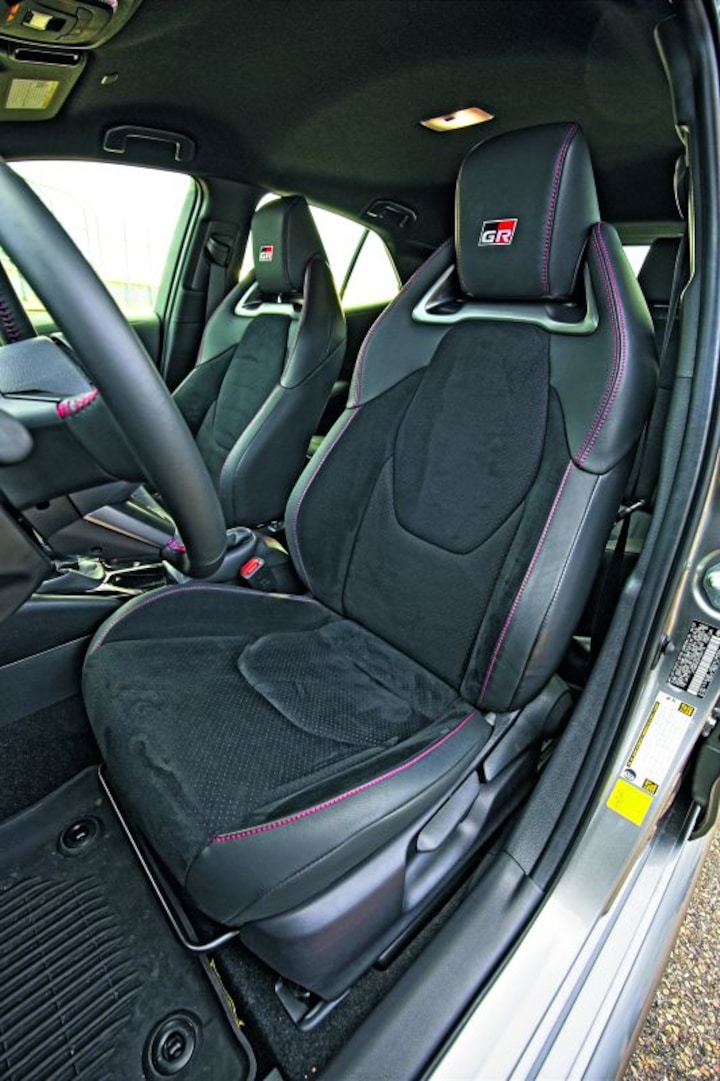
A three-cylinder, does that sound a bit like that?
On to the circuit. Windows down, ears pricked: it is quieter inside than outside – it is the other way around with the GR Yaris. The three pipes trumpet happily when you stand behind the car. However, the three-cylinder engine in the front sounds rather timid, the sound is artificially made sporty through the speakers.
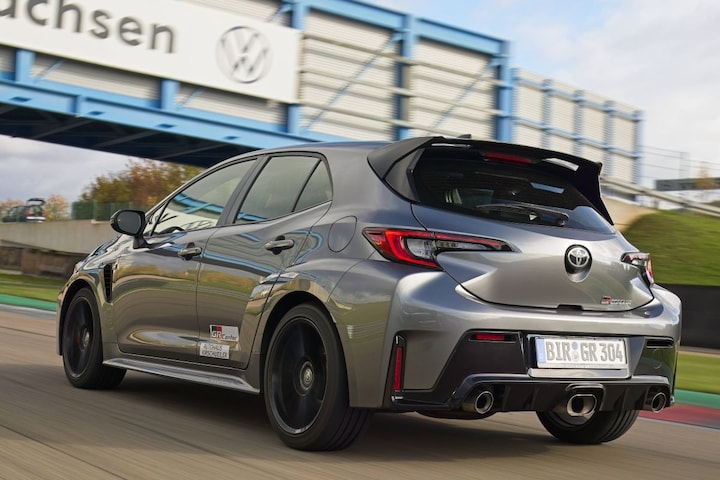
Where does he perform best: track or street?
What the GR Corolla shows on the track is impressive. Emotionally it is on the same level as the Golf R. The Corolla sucks determinedly into the corners and darts around the apex, after which it pulls itself back onto the straight with locked axles. The longer wheelbase and wider Michelin tires set the bar considerably higher than in the GR Yaris. Only when it comes to the engine we are less convinced. Although it pulls a lot, the two-liter turbo engines from AMG, BMW and Volkswagen are much better. That makes it clear once again that you can never have enough cylinder capacity. Driving on the highway is much more relaxed than in the small Yaris, but the top speed, limited to 230 km/h, is laughable. The drive and chassis easily allow 250 km/h and more, a missed opportunity. Consumption continues fine. One in ten on average and more than 1 in 13 if you take it easy.
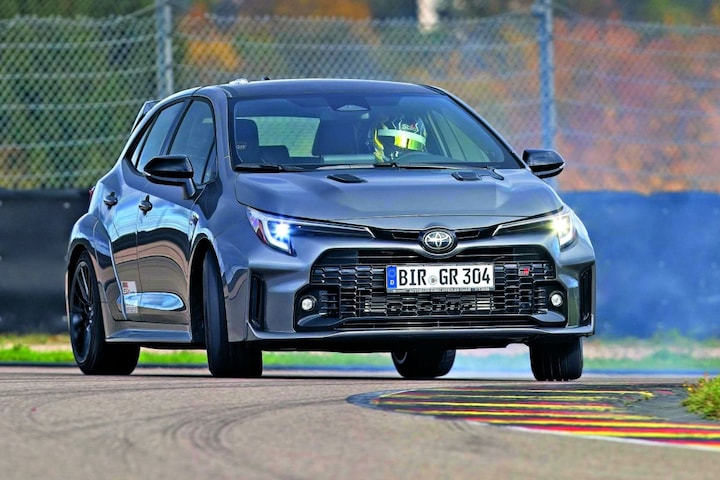
How fast is the GR Corolla?
On the track, the Corolla convinces in terms of longitudinal dynamics. In the starting blocks we hold it in place with the help of the handbrake, give it full throttle and release the clutch with a snap. With light slip on all four wheels, the Corolla revs and accelerates enthusiastically to six thousand rpm. At the very top, just before the rev limiter intervenes, you notice that the turbo engine is really struggling. Nevertheless, if everything falls into place and the precise-feeling six-speed gearbox shifts quickly using a flat shift, you can blast the heavier Corolla to 100 km/h in 5.0 seconds, just as quickly as the GR Yaris. A neat performance, but all in all the three-cylinder engine is too weak for such a sporty bomb. A shame, this car could have easily tolerated 350 to 380 hp.
Technical data
Engine 3 cyl. in-line, turbo
Cylinder capacity 1,618 cc
Max. assets 224 kW/305 hp at 6,500 rpm
Max. couple 370 Nm at 3,000-4,600 rpm
Number of gears 6, manual transmission
Drive four wheels
Dimensions l/w/h 4.41/1.85/1.45 m
Empty weight 1,483 kg
0-100 km/h 5.0 s
Top speed 230 km/h (limited)
Avg. consumption 8.6 l/100 km (1:11.6)
CO2 emissions 191 g/km
– Thanks for information from Autoweek.nl




